非搏動(dòng)性耳鳴
非搏動(dòng)性耳鳴
非搏動(dòng)性耳鳴主要指的是主觀性耳鳴,按病因進(jìn)一步分為特發(fā)性耳鳴(無(wú)明確病因)和繼發(fā)性耳鳴(除感音神經(jīng)性耳聾外存在其他明確病因)。特發(fā)性耳鳴病因尚不清楚。繼發(fā)性耳鳴的主要病因有耳毒性藥物引起的耳鳴、梅尼埃病、偏頭痛、外耳道炎、中耳炎,咽鼓管功能紊亂、耳硬化癥、腫瘤等,但即使去除病因后耳鳴仍可能存在。因此,大量研究證實(shí)外周聽(tīng)覺(jué)系統(tǒng)病變,如噪聲暴露或耳蝸病變導(dǎo)致的聽(tīng)力下降,是主觀性耳鳴的觸發(fā)因素。而中樞神經(jīng)系統(tǒng)中的聽(tīng)覺(jué)系統(tǒng)、邊緣系統(tǒng)等的可塑性改變是主觀性耳鳴發(fā)生和維持的關(guān)鍵。
基于繼發(fā)性耳鳴的病因診斷,有分辨尺度國(guó)際領(lǐng)先(達(dá)0.05mm)的超高分辨率CT、超高端的螺旋CT、超高端的磁共振設(shè)備,有HRCT、雙期增強(qiáng)CT、磁共振高分辨水成像、磁共振動(dòng)態(tài)增強(qiáng)、磁共振內(nèi)耳釓造影等成像技術(shù)檢出病因。在治療方面,有聽(tīng)神經(jīng)瘤切除、中耳炎乳突根治、內(nèi)淋巴囊減壓、佩戴助聽(tīng)器等針對(duì)性治療手段。針對(duì)主觀性耳鳴的發(fā)生機(jī)制,本中心開(kāi)展了以下方面的診斷工作:①采用常規(guī)純音測(cè)試和精細(xì)化純音測(cè)試相結(jié)合的聽(tīng)力學(xué)檢查技術(shù),精準(zhǔn)探查耳鳴患者的隱匿性聽(tīng)力損失;②采用多模態(tài)影像技術(shù)(耳科專用CT、靜息態(tài)功能磁共振技術(shù)、擴(kuò)散張量成像技術(shù)、大腦形態(tài)學(xué)分析技術(shù)、動(dòng)脈自旋標(biāo)記技術(shù))分別從結(jié)構(gòu)、功能、灌注等多維度探究耳鳴腦重塑機(jī)制。在治療方面,有教育和咨詢、認(rèn)知行為治療、聲治療驗(yàn)配、人工耳蝸植入、藥物治療、手術(shù)等個(gè)性化治療手段。
一、主觀性耳鳴評(píng)估技術(shù):
1. DTI技術(shù)
本中心首次采用擴(kuò)散張量成像技術(shù)(DTI)評(píng)估了不同側(cè)別(左側(cè)、右側(cè))特發(fā)性耳鳴患者的大腦白質(zhì)變化特征,發(fā)現(xiàn)耳鳴側(cè)別對(duì)患者的腦白質(zhì)異常變化存在重大影響,其中左側(cè)耳鳴患者較右側(cè)耳鳴患者腦白質(zhì)體積及微觀結(jié)構(gòu)變化更明顯。
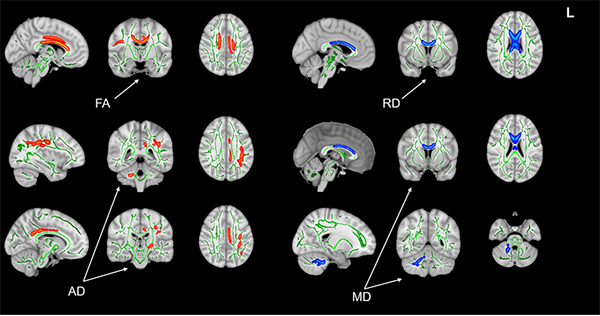
圖1.左側(cè)耳鳴患者與右側(cè)耳鳴患者腦白質(zhì)微結(jié)構(gòu)變化存在顯著差異(紅色代表升高,藍(lán)色代表降低)
2. VBM技術(shù)
本中心采用基于體素形態(tài)學(xué)方法(VBM)評(píng)估了療效不同耳鳴患者腦結(jié)構(gòu)變化特征,證實(shí)右側(cè)額中回、中央前回可能是預(yù)測(cè)特發(fā)性耳鳴治療效果的影像標(biāo)志物,同時(shí)為聲音治療前患者篩選提供了依據(jù)。
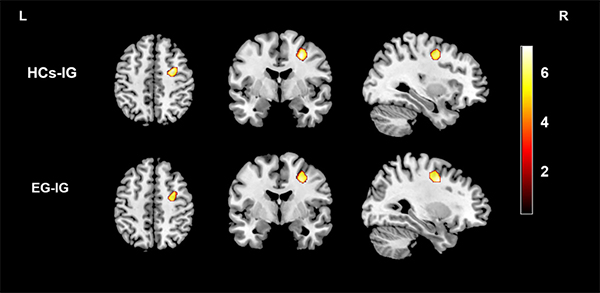
圖2. 治療效果不同耳鳴患者腦結(jié)構(gòu)變化差異區(qū)域(右側(cè)額中回、中央前回)
3. fMRI技術(shù)
本中心采用組水平獨(dú)立成分分析方法(GCA)評(píng)估了療效不同耳鳴患者靜息態(tài)腦網(wǎng)絡(luò)變化特征,證實(shí)前默認(rèn)網(wǎng)絡(luò)及聽(tīng)覺(jué)網(wǎng)絡(luò)內(nèi)功能連接變化可能是預(yù)測(cè)原發(fā)性耳鳴療效的影像標(biāo)志物,同時(shí)為治療前的患者篩選提供了依據(jù)。
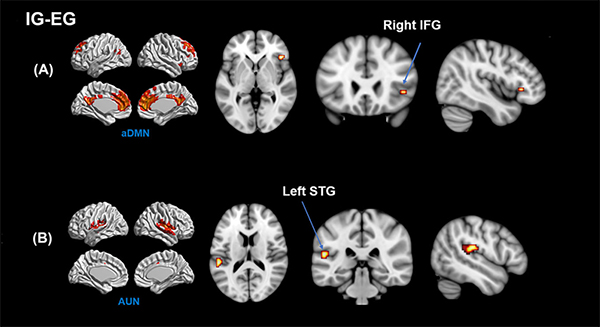
圖3. 治療效果不同耳鳴患者腦網(wǎng)絡(luò)變化差異區(qū)域(aDMN:前默認(rèn)網(wǎng)絡(luò);AUN:聽(tīng)覺(jué)網(wǎng)絡(luò))
4. ASL技術(shù)
動(dòng)脈自旋標(biāo)記技術(shù)是以動(dòng)脈血作為內(nèi)源性示蹤劑,可無(wú)創(chuàng)評(píng)估腦灌注狀態(tài)。本中心基于ASL技術(shù)評(píng)估了主觀性耳鳴患者聽(tīng)覺(jué)皮層的灌注狀態(tài),發(fā)現(xiàn)耳鳴患者的雙側(cè)初級(jí)聽(tīng)覺(jué)皮層的腦血流量顯著增高,并且左側(cè)初級(jí)聽(tīng)覺(jué)皮層的CBF與耳鳴嚴(yán)重程度呈正相關(guān)。
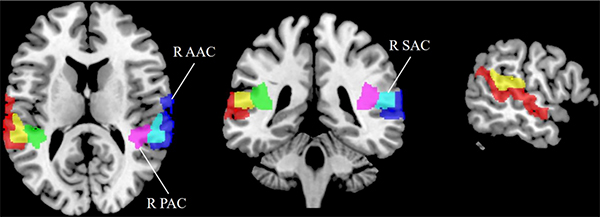
圖4.主觀性耳鳴患者雙側(cè)聽(tīng)覺(jué)皮層腦血流改變
二、治療手段
1.窄帶聲治療
聲治療是目前指南推薦且臨床最常用的耳鳴一線治療方式。本中心前期招募特發(fā)性耳鳴患者給與6個(gè)月窄帶聲治療,并采用多模態(tài)磁共振手段評(píng)估其療效。首次發(fā)現(xiàn)聲治療后耳鳴患者右側(cè)海馬旁回、右側(cè)尾狀核、左側(cè)顳上回、左側(cè)楔狀和右側(cè)距狀回等區(qū)域灰質(zhì)體積降低趨于正常,患者臨床癥狀顯著改善。證實(shí)聲治療對(duì)耳鳴患者皮層萎縮具有積極治療效果。
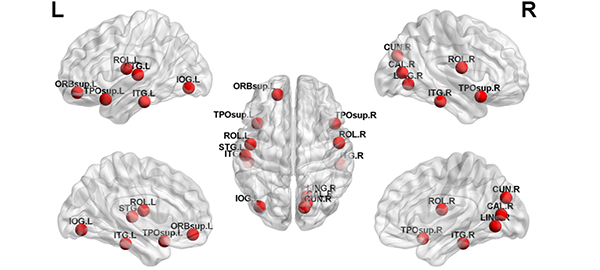
圖5.特發(fā)性耳鳴患者6個(gè)月聲治療前后腦結(jié)構(gòu)差異區(qū)域
2.多元復(fù)合聲治療
根據(jù)耳鳴匹配和殘余抑制的結(jié)果給患者定制個(gè)性化聲。以耳鳴匹配頻率為中心頻率選擇窄帶噪聲,響度的設(shè)定以剛好掩蓋患者耳鳴聲為標(biāo)準(zhǔn)進(jìn)行設(shè)定,并將窄帶噪聲、自然環(huán)境背景聲、音樂(lè)聲通過(guò)平臺(tái)自帶系統(tǒng)進(jìn)行聲處理融合后進(jìn)行雙耳給聲聲治療。其中自然環(huán)境背景和音樂(lè)聲均根據(jù)患者的喜好由患者自行選擇,響度可根據(jù)患者的舒適度自行選擇。
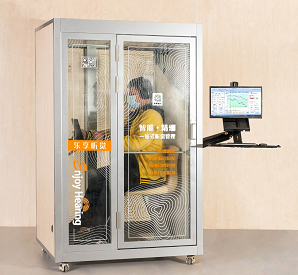
圖6.多元復(fù)合聲治療平臺(tái)
3.切跡音樂(lè)治療
該治療方案根據(jù)耳鳴患者的純音聽(tīng)力、耳鳴頻率匹配、患者自主選擇喜愛(ài)音樂(lè)的結(jié)果進(jìn)行個(gè)性化切跡治療。具體流程如下:①根據(jù)患者選取的音樂(lè)頻譜特征,對(duì)頻譜能量按照從低到高進(jìn)行再分配,使能量譜均衡化;②去除均衡化后的音樂(lè)中以耳鳴頻率為中心的1/2 倍的頻帶;③在去除后的切口邊緣兩側(cè)的3/8倍頻程寬度內(nèi)增加響度20 dB,使切跡音樂(lè)所引起的側(cè)向抑制效果最大。經(jīng)過(guò)上述步驟,得到每名患者專屬的個(gè)性化切跡音樂(lè)。
三、研究方向
1、基于靜息態(tài)功能磁共振單側(cè)靜脈源性耳鳴的腦中樞化機(jī)制研究
2、基于多模態(tài)腦影像拓?fù)涮卣鞯亩Q聲治療療效預(yù)測(cè)模型研究
3、基于多尺度多模式成像探究耳鳴小鼠模型的聽(tīng)覺(jué)-邊緣系統(tǒng)神經(jīng)重塑機(jī)制
4、耳鳴的神經(jīng)血管偶聯(lián)機(jī)制研究
四、階段性成果(近5年)
1. Lv, H., Liu, J., Chen, Q., Ji, J., Zhai, J., Zhang, Z., Wang, Z., Gong, S., & Wang, Z. (2024). Brain Network Evaluation by Functional-Guided Effective Connectivity Reinforcement Learning Method Indicates Therapeutic Effect for Tinnitus. IEEE Trans. Neural Syst. Rehabil. Eng. 32, 1132-1141. doi: 10.1109/TNSRE.2024.3373335.
2. Lv, H., Liu, J., Chen, Q., Zhang, Z., Wang, Z., Gong, S., Ji, J., & Wang, Z. (2023). Brain Effective Connectivity Analysis Facilitates the Treatment Outcome Expectation of Sound Therapy in Patients With Tinnitus. IEEE Trans. Neural Syst. Rehabil. Eng. 31, 1158-1166. Doi: 10.1109/TNSRE.2023.3241941.
3. Chen, Q., Lv, H., Wang, Z., Li, X., Wang, X., Huang, Y., Zhao, P., Yang, Z., Gong, S., & Wang, Z. (2023). Multimodal quantitative magnetic resonance imaging of the thalamus in tinnitus patients with different outcomes after sound therapy. CNS Neurosci. Ther. 29, 4070-4081. doi: 10.1111/cns.14330.
4. Chen, Q., Lv, H., Wang, Z., Li, X., Wang, X., Huang, Y., Zhao, P., Yang, Z., Gong, S., & Wang, Z. (2023). Role of insula and its subregions in progression from recent onset to chronic idiopathic tinnitus. Brain Commun. 5, fcad261. doi: 10.1093/braincomms/fcad261.
5. Chen, Q., Lv, H., Wang, Z., Wei, X., Liu, J., Liu, F., Zhao, P., Yang, Z., Gong, S., & Wang, Z. (2022). Distinct brain structural‐functional network topological coupling explains different outcomes in tinnitus patients treated with sound therapy. Hum. Brain Mapp. 43, 3245-3256. Doi: 10.1002/hbm.25848.
6. Chen, Q., Lv, H., Wang, Z., Wei, X., Zhao, P., Yang, Z., Gong, S., & Wang, Z. (2021). Outcomes at 6?months are related to brain structural and white matter microstructural reorganization in idiopathic tinnitus patients treated with sound therapy. Hum. Brain Mapp. 42, 753-765. doi: 10.1002/hbm.25260.
7. Chen, Q., Lv, H., Wang, Z., Wei, X., Zhao, P., Yang, Z., Gong, S., & Wang, Z. (2022). Lateralization effects in brain white matter reorganization in patients with unilateral idiopathic tinnitus: a preliminary study. Brain Imaging Behav. 16, 11-21. Doi: 10.1007/s11682-021-00472-1.
8. Chen, Q., Lv, H., Wang, Z., Wei, X., Zhao, P., Yang, Z., Gong, S., & Wang, Z. (2021). Brain Structural and Functional Reorganization in Tinnitus Patients Without Hearing Loss After Sound Therapy: A Preliminary Longitudinal Study. Front. Neurosci. 15, Article 573858. doi: 10.3389/fnins.2021.573858.
9. Chen, Q., Lv, H., Wang, Z., Wei, X., Liu, J., Zhao, P., Yang, Z., Gong, S., & Wang, Z. (2021). Pretreatment intranetwork connectivity can predict the outcomes in idiopathic tinnitus patients treated with sound therapy. Hum. Brain Mapp. 42, 4762-4776. doi: 10.1002/hbm.25584.
10. Chen, Q., Lv, H., Chen, Y., Song, J., & Wang, Z. (2021). Editorial: Neuroimaging Approaches to the Study of Tinnitus and Hyperacusis. Front. Neurosci. 15, 700670. doi: 10.3389/fnins.2021.700670.
11. Chen, Q., Wang, Z., Lv, H., Zhao, P., Yang, Z., Gong, S., & Wang, Z. (2020). Reorganization of Brain White Matter in Persistent Idiopathic Tinnitus Patients Without Hearing Loss: Evidence From Baseline Data. Front. Neurosci. 14, 591. doi: 10.3389/fnins.2020.00591.
12. Wei, X., Lv, H., Chen, Q., Wang, Z., Liu, C., Zhao, P., Gong, S., Yang, Z., & Wang, Z. (2021). Neuroanatomical Alterations in Patients With Tinnitus Before and After Sound Therapy: A Combined VBM and SCN Study. Front. Hum. Neurosci. 14, 607452. Doi: 10.3389/fnhum.2020.607452.
13. Wei, X., Lv, H., Chen, Q., Wang, Z., Liu, C., Zhao, P., Gong, S., Yang, Z., & Wang, Z. (2021). Cortical Thickness Alterations in Patients With Tinnitus Before and After Sound Therapy: A Surface-Based Morphometry Study. Front. Neurosci. 15, 633364. Doi: 10.3389/fnins.2021.633364.
14. Wei, X., Lv, H., Chen, Q., Wang, Z., Zhao, P., Liu, C., Gong, S., Yang, Z., & Wang, Z. (2021). Surface-Based Amplitude of Low-Frequency Fluctuation Alterations in Patients With Tinnitus Before and After Sound Therapy: A Resting-State Functional Magnetic Resonance Imaging Study. Front. Neurosci. 15, 709482. Doi: 10.3389/fnins.2021.709482.
15. Wei, X., Lv, H., Wang, Z., Liu, C., Ren, P., Zhang, P., Chen, Q., Liu, Y., Zhao, P., Gong, S., Yang, Z., & Wang, Z. (2020). Neuroanatomical Alterations in Patients With Tinnitus Before and After Sound Therapy: A Voxel-Based Morphometry Study. Front. Neurosci. 14, 911. doi: 10.3389/fnins.2020.00911.
16. Lv, H., Chen, Q., Wei, X., Liu, C., Zhao, P., Wang, Z., Yang, Z., Gong, S., You, H., & Wang, Z. (2021). Sound therapy can modulate the functional connectivity of the auditory network. Progress in Neuro-Psychopharmacology and Biological Psychiatry 110, 110323. Doi: 10.1016/j.pnpbp.2021.110323.
17. Lv, H., Liu, C., Wang, Z., Zhao, P., Cheng, X., Yang, Z., Gong, S., & Wang, Z. (2020). Altered functional connectivity of the thalamus in tinnitus patients is correlated with symptom alleviation after sound therapy. Brain Imaging Behav. 14, 2668-2678. Doi: 10.1007/s11682-019-00218-0.
18. Han, L., Pengfei, Z., Chunli, L., Zhaodi, W., Xindi, W., Qian, C., Shusheng, G., & Zhenchang, W. (2020). The effects of sound therapy in tinnitus are characterized by altered limbic and auditory networks. Brain Commun. 2. doi: 10.1093/braincomms/fcaa131.
19. Han, L., Na, Z., Chunli, L., Yuchen, C., Pengfei, Z., Hao, W., Xu, C., Peng, Z., Zheng, W., Zhenghan, Y., Shusheng, G., & Zhenchang, W. (2019). Baseline Functional Connectivity Features of Neural Network Nodes Can Predict Improvement After Sound Therapy Through Adjusted Narrow Band Noise in Tinnitus Patients. Front. Neurosci. 13, 614. Doi: 10.3389/fnins.2019.00614.
20. Han, L., Na, Z., Chunli, L., Yuchen, C., Pengfei, Z., Hao, W., Xu, C., Peng, Z., Zheng, W., Zhenghan, Y., Shusheng, G., & Zhenchang, W. (2019). Baseline Functional Connectivity Features of Neural Network Nodes Can Predict Improvement After Sound Therapy Through Adjusted Narrow Band Noise in Tinnitus Patients. Front. Neurosci. 13, 614. doi: 10.3389/fnins.2019.00614.
21. Li X, Zhao Y, Hui Y, Wu Y, Chen Q, Shi H, Lv H, Li M, Zhao, P, Zhang, W, Zhao, X, Li, J, Cui, L, Wang, Z. (2022). Lateralization of cerebral blood flow in the auditory cortex of patients with idiopathic tinnitus and healthy controls: An arterial spin labeling study. Front Neurosci. 16, 992758. doi: 10.3389/fnins.2022.992758.

在線問(wèn)卷


 微博
微博 微信
微信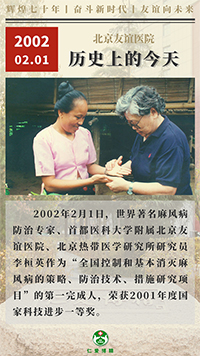

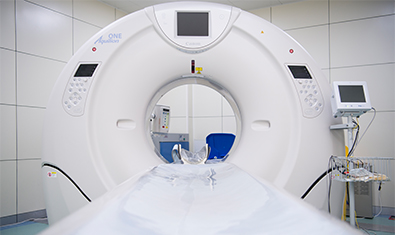
 京公網(wǎng)安備11010202008305號(hào)
京公網(wǎng)安備11010202008305號(hào)